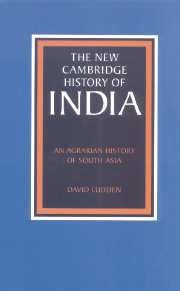Introduction
Published online by Cambridge University Press: 28 March 2008
Summary
This book is about history’s attachment to land. It considers the present day in the context of the past two millennia, because a wide historical view is needed to appreciate the ideas that shape contemporary mentalities, and because earthly environments today are being shaped by long-term historical forces. As the book goes on, I consider some elements of Eurasian history and introduce some ideas about geography, technology, patriarchy, ritual, ecology, and other subjects that situate South Asian farmers in their wider world. I also indicate that more research into the historical dynamics of territoriality is needed to improve our knowledge of culture and political economy. But, like other volumes in The New Cambridge History of India, the main goal of this book is to draw together research by many scholars on a coherent set of historical themes without rehearsing academic debates or piling up citations. The bibliographical essay is a guide to relevant literature that sprawls across the disciplines of history, anthropology, economics, geography, political science, and rural sociology. I apologise for not covering many regions well enough and particularly for slighting Assam, Baluchistan, Chhattisgarh, Kerala, Nepal, Orissa, and Sri Lanka. This failure results partly from the state of research but mostly from my own inability to compile appropriate data in the time and space allotted. For these reasons, territories in Bangladesh, India, and Pakistan form my central subject matter.
- Type
- Chapter
- Information
- An Agrarian History of South Asia , pp. 1 - 5Publisher: Cambridge University PressPrint publication year: 1999

